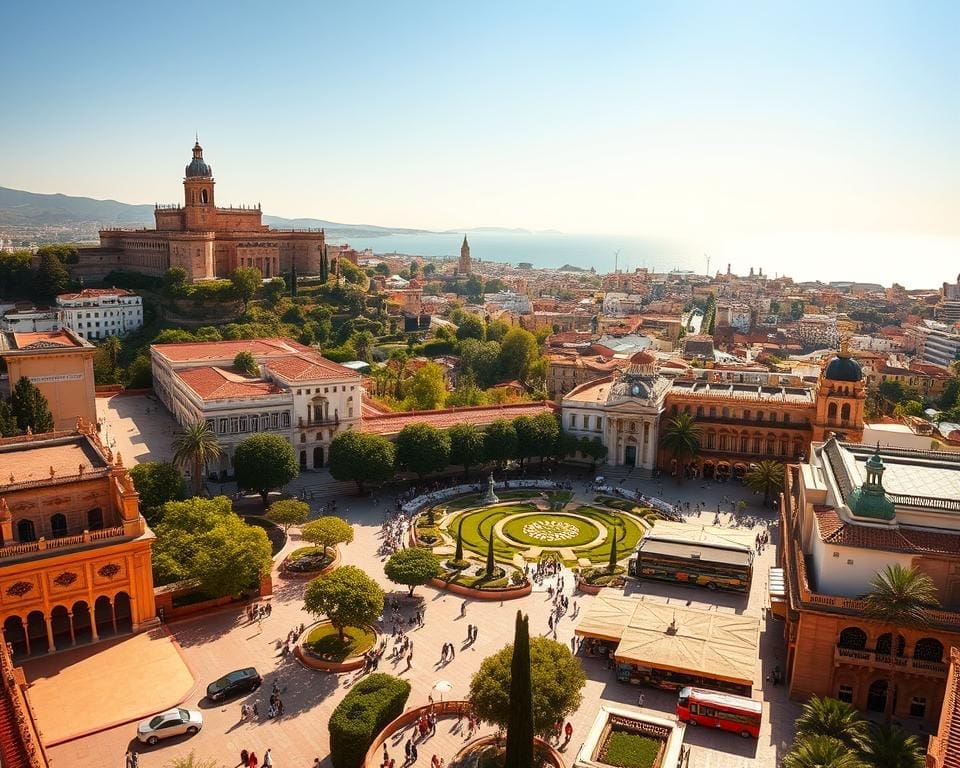Welcome to Andalusia, a captivating region in southern Spain, where vibrant cultures and stunning landscapes await. In this city comparison, we delve into two of its most inviting cities: Malaga and Seville. Each city boasts its own unique charm and allure, making the debate over which is the best city an inspiring exploration for any traveller. From Malaga’s beautiful beaches to Seville’s architectural wonders, your adventure in Andalusia promises to be unforgettable.
Introduction to Andalusia: Exploring the Heart of Southern Spain
Andalusia, located in Southern Spain, is a region brimming with rich cultural heritage and mesmerizing landscapes. As one ventures into this enchanting part of the country, the vibrant traditions rooted in its history reveal themselves, from Moorish architectural marvels to the passionate rhythms of flamenco music.
The geographical significance of Andalusia cannot be overstated. This sun-drenched region enjoys a warm Mediterranean climate, perfect for exploring its array of historic cities and natural beauty. Visitors can wander through bustling plazas, sample tantalising cuisine, and admire breathtaking views, all while embracing the local customs that make Andalusia a unique destination.

In this travel guide, discover an alluring mix of experiences that await in Andalusia, where ancient history and natural wonders coalesce. Attractive cities filled with charm and character beckon tourists eager to uncover the secrets of Southern Spain. This is more than just a destination; it is an invitation to immerse oneself in the captivating essence of a region that celebrates life, art, and community.
Malaga: A Coastal Gem of Spain
Malaga stands out as a stunning coastal city, offering visitors an unparalleled experience enriched by its natural beauty and vibrant culture. Known for its pristine beaches and picturesque landscapes, this Mediterranean destination continues to capture the hearts of both locals and tourists.
Beaches and Natural Beauty
Malaga boasts some of the most beautiful beaches along the Costa del Sol. La Malagueta, with its golden sands and inviting waters, attracts sun-seekers eager to bask in the Mediterranean sun. The charming neighbourhood of Pedregalejo offers a more laid-back atmosphere, perfect for those who wish to enjoy a leisurely stroll by the shoreline. Nature lovers will appreciate the diverse natural landscapes surrounding the coastal city, providing ample opportunities for exploration and adventure.
Cultural and Historical Significance
Beyond its scenic allure, Malaga’s cultural significance is immense. This coastal city is renowned as the birthplace of the iconic painter Pablo Picasso, and numerous galleries celebrate his artistic contributions. Visitors can explore the Picasso Museum, which showcases an extensive collection of his works, reflecting the depths of his genius. Additionally, historical landmarks such as the Alcazaba and the Roman theatre offer intriguing insights into the region’s rich past, making Malaga a must-see for those interested in cultural attractions.
Seville: The Quintessential Spanish City
Seville, a city bursting with character, stands as a testament to Spain’s rich cultural tapestry. Its skyline is dominated by architectural marvels that narrate tales of centuries past, while the pulse of flamenco resonates through its streets, capturing the essence of Spanish culture.
Architectural Marvels and Landmarks
The city is home to several iconic landmarks that draw visitors from around the globe. The Seville Cathedral, known for its grandeur, is one of the largest cathedrals in the world and reflects the city’s historical significance. Adjacent to this masterpiece is the Giralda tower, an architectural marvel that was initially built as a minaret, symbolising the city’s rich Moorish heritage.
Flamenco and Local Culture
The spirit of Seville ignites through flamenco, a passionate dance and music genre that embodies the heart of Spanish culture. Its roots in the city run deep, showcased in vibrant festivals such as the Feria de Abril, where locals and visitors immerse themselves in the lively rhythms and colourful traditions. The interplay of music, dance, and celebration epitomises Seville’s cultural identity, ensuring every visitor leaves with unforgettable memories.
Malaga or Seville? Which City is Better for Tourists?
When considering a visit to Southern Spain, the decision between Malaga or Seville becomes pivotal for an unforgettable travel experience. Both cities offer unique charms and adventures tailored for diverse types of tourists. Malaga, with its stunning coastline and relaxed atmosphere, presents an ideal setting for those looking to unwind. Sun-soaked beaches and vibrant promenades invite leisurely strolls or energetic days by the sea.
On the other hand, Seville bursts with rich cultural significance and architectural wonders. Its vibrant festivals and historic sites create an alluring backdrop for travellers interested in deepening their knowledge of Spanish heritage. Tourists can savour the essence of Flamenco dancing or marvel at the intricacies of the Alcázar, enhancing their understanding of Andalusian culture.
Accessibility plays a crucial role when choosing the best city for tourists, with both locations offering efficient transport links. Malaga boasts a modern airport and straightforward connections to the Costa del Sol. In comparison, Seville provides an exceptional railway network, making it easy to explore nearby cities. The diversity of activities ensures that both cities cater to families, couples, and solo adventurers alike.
Nightlife in Malaga thrives with beach clubs and vibrant bars, while Seville enchants with its intimate tapas bars and lively flamenco shows. Shopping enthusiasts can revel in Malaga’s quaint boutiques or explore Seville’s bustling markets. Both cities present a delightful mix for every traveller’s taste.
Understanding individual preferences ultimately leads to a tailored travel experience. From the relaxation of Malaga’s sunny beaches to the cultural richness found in the streets of Seville, both cities hold their own treasures waiting to be discovered. Whether it’s the allure of a coastal escape or the draw of a bustling city filled with history, the choice hinges on what you seek from your journey in Andalusia.
Top Tourist Attractions in Malaga
Malaga, steeped in history and culture, offers a wealth of captivating experiences for visitors. Among the most prominent tourist attractions in Malaga, the Picasso Museum stands out as a must-visit site, showcasing the remarkable legacy of Pablo Picasso. This museum not only highlights the artist’s iconic works but also immerses tourists in the broader art movement that flourished during his time. The gallery creates a dialogue between Picasso’s creations and the cultural context of Malaga, providing a unique insight into his creative journey.
Picasso Museum and Its Influence
The Picasso Museum is situated in a beautifully restored 16th-century palace, enhancing the experience for art enthusiasts. The collection boasts a diverse array of paintings, drawings, and ceramics, representing various stages of Picasso’s artistic evolution. Each piece captures a moment in his life, reflecting both personal and political influences. Visitors often find themselves absorbed in the atmosphere, which resonates with the spirit of one of the 20th century’s most celebrated artists. The museum’s educational programmes further contribute to its significance, offering workshops and guided tours that engage audiences of all ages.
Malaga Cathedral: An Architectural Wonder
The Malaga Cathedral, another gem among the tourist attractions in Malaga, showcases the city’s rich architectural heritage. Often referred to as “La Manquita,” or the one-armed lady, this magnificent Renaissance cathedral leaves visitors in awe with its stunning façade and majestic tower. The construction dates back to the 16th century, and its intricate details reflect the artistic craftsmanship of the era. Inside, the cathedral features magnificent altars and beautiful chapels, making it a perfect setting for reflection and admiration. The history surrounding its construction, including the tales of its incomplete second tower, adds to the intrigue, captivating all who step through its doors.
Top Tourist Attractions in Seville
Seville, a city steeped in history and rich in culture, offers a myriad of remarkable tourist attractions in Seville. Among these, the Alcázar of Seville stands as an iconic testament to the city’s historical and architectural prowess. Recognised as a UNESCO World Heritage Site, this stunning palace complex captivates visitors with its intricate architecture and lush gardens. The Alcázar showcases a blend of Mudéjar, Gothic, Renaissance, and Baroque influences, revealing the cultural confluence that defines this enchanting city.
The Alcázar of Seville: A UNESCO World Heritage Site
Exploring the Alcázar is akin to stepping into a living museum. Each nook and cranny tells a story, featuring breathtaking tile work and remarkable courtyards. The gardens invite visitors to wander through shaded arbours and tranquil fountains, providing a serene escape from the bustling city life. Recognising its significance, the Alcázar has been included in several popular films, further solidifying its status as one of the top cultural landmarks in Seville.
Metropol Parasol: Modern meets Tradition
In contrast to the historical elegance of the Alcázar, the Metropol Parasol introduces a contemporary flair to Seville’s skyline. This architectural marvel, often referred to as “Las Setas,” is a striking wooden structure that serves both functional and aesthetic purposes. Rising above the ancient streets, it offers panoramic views of the city from its elevated walkway. The Metropol Parasol ingeniously blends modern design with the historic surroundings, representing the innovative spirit of Seville while standing as one of the must-see tourist attractions in Seville.
Gastronomy: Culinary Delights of Each City
The vibrant gastronomy of Andalusia captivates food lovers with its rich flavours and distinctive culinary traditions. Both Malaga and Seville boast unique offerings, highlighting the culinary delights that define their local identities. From fresh ingredients sourced from their coastal locations to recipes steeped in centuries of tradition, these cities provide a gastronomic journey worth exploring.
Signature Dishes of Malaga
Malaga is renowned for its seafood, with signature dishes such as Espetos—grilled sardines skewered on sticks and cooked over an open flame. This dish represents the essence of coastal dining, where freshness meets simple yet delicious preparation. Another must-try is Ajoblanco, a refreshing cold almond soup, perfect for warm days. These culinary delights not only showcase local ingredients but also reflect the city’s deep-rooted gastronomic heritage.
Culinary Traditions of Seville
In Seville, the culinary scene shines through its famous tapas culture, offering a myriad of small plates that encourage sharing and socialising. Fino sherry, produced in the nearby Jerez region, complements the rich array of flavours found in Seville’s tapas bars. Traditional dishes such as Salmorejo—a thicker cousin of gazpacho—highlight the region’s emphasis on the importance of local produce. Markets like Mercado de Triana pulse with life and flavour, providing a glimpse into authentic local experiences that define the gastronomy of this vibrant city.
Travel Tips for Visiting Malaga and Seville
When planning your journey through the enchanting landscapes of Andalusia, essential travel tips can enhance your experience when visiting Malaga and Seville. The best times to visit span from spring to early autumn, when the weather is pleasantly warm. Public transport in both cities is efficient; Malaga boasts a reliable metro and bus system, while Seville’s trams offer convenient city navigation. For a more local experience, consider renting a bicycle to explore Malaga’s beautiful coastal paths or Seville’s historic streets.
Accommodation options in both cities vary from luxurious hotels to charming guesthouses, catering to diverse budgets. When visiting Seville, don’t miss the chance to stay near the historic centre, as it allows for easy access to major attractions. In contrast, if you prefer the coastal breeze, choose a hotel in Malaga that offers scenic views of the Mediterranean. It’s advisable to book in advance, particularly during peak tourist seasons, to secure your ideal lodging.
Language can often be a hurdle; however, a few basic Spanish phrases can go a long way. Locals appreciate any effort to communicate in their language, so try learning common greetings and phrases before your trip. Additionally, be mindful of traditional customs—such as siesta, which sees shops and businesses close in the afternoon. Embracing these local customs will not only enrich your experience but also foster a deeper connection with the vibrant cultures found in both Malaga and Seville.









